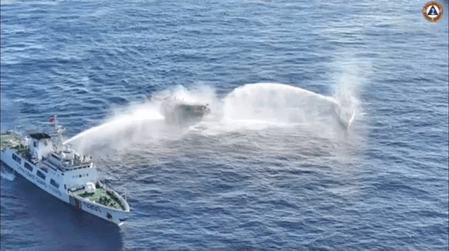SUMMARY
This is AI generated summarization, which may have errors. For context, always refer to the full article.

MANILA, Philippines – A marine biologist who led the recent marine scientific research (MSR) in Pag-asa (Thitu) Island estimated that the damage on coral reefs in the isolated cays may have been going on for “
“several years already.”
“The ones that are underwater, from, let’s say, 7 meters deep to around 20 meters deep away from the pile of rubble itself, I think those dead corals have been dead for some time, for a long time,” Jonathan Anticamara, professor at the University of the Philippines Institute of Biology, said in a Rappler Talk interview on Friday, May 10.
The scientist said the color of algae and its prevalence on the ocean floor are indications that the corals have been damaged for some time.
“[T]he ocean floor is now covered with many, many algae,” Anticamara said. “And not only [for] Pag-asa Island itself, but for the cays themselves. So, I think that’s happened for a very long period. Maybe…several years already that’s ongoing.”
“[T]he algae are now brown and black,” he added. “Usually, when the corals die recently, the algae that would cover it would be green and the corals would be partially white. But most of these dead corals are now either black or gray.”
Anticamara led the MSR last March with an eight-member team, with six people coming from the Bureau of Fisheries and Aquatic Resources. Anticamara himself surveyed Sandy Cays 1, 2, and 3. There are four cays in the vicinity of Pag-asa.
According to their report, the coral reefs in the cays are now in a degraded state, and fish species in the area are few in number and small in size.
The cays are located far from the Philippines’ mainland. Before they conducted their MSR, Anticamara said he had expected to find a healthy ecosystem in Pag-asa Island because of its distance and the lack of commercial fish trade in the area. (IN PHOTOS: Coast Guard brings doctors, nurses, teachers to Pag-asa Island)

Rubble of dead corals
Who destroyed the corals? And why?
In the cays, rubble of dead corals were found piled on top of live colonies. Anticamara said these might be “recent” since the rubble were still white and without algae. However, the piling of dead corals over live ones could endanger the latter.
“The direct impact of rubble on top of corals is that it would kill these corals. They won’t be able to survive,” Anticamara explained.
The Philippine Coast Guard had already called out China for the environmental and coral reef destruction in the island and the cays.
But why would China pile dead corals on top of live ones?
Retired Supreme Court senior associate justice Antonio Carpio pointed to another feature in the vicinity: the Chinese-occupied Subi Reef (Zamora Reef).
In a statement last May 5, Carpio said China wanted to create a high-tide geologic feature between Pag-asa Island and Subi Reef. The Arbitral Tribunal had already ruled that Subi Reef is part of Pag-asa’s 12-nautical mile territorial sea, and China wants this reversed.
A high-tide elevation feature between Pag-asa Island and Subi Reef would mean having “a full 12-nautical mile territorial sea to include Subi Reef.”
“The result is that Subi Reef, which is now an artificial island hosting a huge Chinese air and naval base, will no longer form part of the territorial sea of Pag-asa, whose territorial sea will be reduced by about one-third,” Carpio said.
As dead coral rubble “are being surreptitiously piled by China so that it will appear naturally formed and not man-made,” Carpio said the Philippines must document these attempts and be prepared to bring this “illegal artificial island building of China” to an United Nations Convention on the Law of the Sea arbitral tribunal.
Protection needed
The recent MSR emphasized the need for a systematic preservation of these marine resources.
According to Anticamara, the Philippines needs large-scale management “to achieve effective ecosystem conservation.”
Lawmakers have been pushing to declare the 3 nautical miles around the Kalayaan Island Group and the Scarborough Shoal as a marine protected area.
The marine biologist emphasized that corals are the most productive of underwater ecosystems, providing food and shelter for many marine species.
“On top of the political tensions…I think we just need to tell ourselves really that we should be responsible, and we should take care of these resources,” said Anticamara.
“Nobody else will take care of these resources [but] the Filipinos themselves.” – Rappler.com
Add a comment
How does this make you feel?












![[OPINION] Grading Marcos admin’s performance on the climate agenda](https://www.rappler.com/tachyon/2024/06/grading-marcos-performance-climate-agenda-june-25-2025.jpg?resize=257%2C257&crop=441px%2C0px%2C1080px%2C1080px)





There are no comments yet. Add your comment to start the conversation.